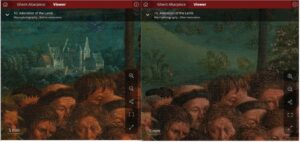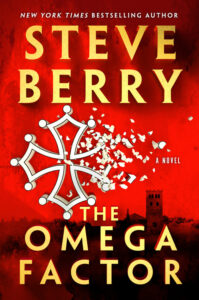Within St. Bavo’s Cathedral in Ghent, Belgium stands a masterpiece. Not the first work ever painted in oil, but definitely the first to maximize all of the advantages that new medium offered. In total it is a sublime example of Northern Renaissance expression and has the distinction of being the most stolen, damaged, and vandalized work of art in the world.
It’s name?
The Adoration of the Mystic Lamb or, as it is more widely known, the Ghent Altarpiece.
Which takes center stage in my new novel The Omega Factor.
It was created by two brothers. Started by Hubert van Eyck in 1426, and finished by Jan van Eyck in 1432. This is known thanks to a Latin poem inscribed on the altarpiece, which lay undiscovered until 1823. The painter Hubert van Eyck, a greater man than whom cannot be found, began this work. Jan, his brother, second in art, completed this weighty task at the request of Joos Vijd. He invites you with this verse, on the sixth of May [1432], to look at what has been done. The best guess is that Hubert conceived the overall compositional design, which Jan eventually painted after his death, adding many of his own touches.
It’s a hefty piece, consisting of eighteen separate panels depicting lifelike portraits alongside biblical figures and holy scenes. When opened it measures roughly eleven feet tall by fifteen feet wide, and there are images front and back. Interestingly, in centuries past the polyptych was only opened during mass, so for the vast majority of its nearly 600 year life it stood closed. Today, it can be viewed in all its glory, front and back, behind protective glass.
In medieval days paintings were almost always the product of a private commission from a wealthy patron, created so that those wealthy patrons could donate the work to a church, cathedral, or convent to demonstrate their pious generosity. The Ghent Altarpiece was commissioned by Joos Vijd and his wife, Elizabeth Borluut, installed above the altar of a chapel they founded.
When opened, all of the lower panels create a continuous landscape, where crowds of people travel from all parts of the earth to witness the Lamb of God, in the center panel, upon the altar. There are vast swaths of countryside, distant cityscapes, and countless figures. Jan van Eyck was a skilled miniaturist, capable of painting in the smallest detail. An example comes in the angelic musicians. Van Eyck’s attention to detail is so precise that we can actually tell what notes are being played on the organ. Historians have also pointed out that it is also possible to know which of the singing angels is a soprano, alto, tenor, or bass simply through their painted expressions.
Since 2012, the altarpiece has been undergoing restoration by Belgium’s Royal Institute for Cultural Heritage. The result has been a miraculous transformation, the painting restored to its original splendor. During that restoration, though, something interesting occurred that is highly relevant to The Omega Factor.
On the center panel, toward the top left, appeared a house in miniature. I came across it during my research. The left image below shows that house. I was so intrigued that I made the structure an integral part of the story.

After the novel was finished and submitted for publication I discovered something fascinating. During the restoration of the center panel, the house was removed. The right image shows the current state of the center panel.
Talk about weird.
And what are the odds?
You also have to wonder. Why remove the house? Was it original to the work, painted by Jan van Eyck? Or was it added sometime later as overpaint, which was all removed during the current restoration? But perhaps there is a third explanation. Is the house itself best left unknown?
Who knows?
But it definitely makes great fodder for a novelist.
And this is not the only mystery associated with the altarpiece. Thirteen times since the 15th century the panels have been subject to damage, destruction, or theft. Which makes one wonder? What is it about this particular work of art that generates such violent reactions? Then there is the theft of the panel known as The Just Judges which occupies a position at the lower left.
Sometime during the night of April 10, 1934 the Just Judges was removed from its oak frame and stolen from St. Bavos Cathedral. A note was left, written in French. Taken from Germany by the Treaty of Versailles. A clear reference to the altarpiece’s plunder by German forces during World War I, only returned to Belgium in accordance with the Treaty of Versailles. The subsequent police investigations were inept, the only serious search for the panel’s whereabouts occurring many years later. Twenty days after the theft, the bishop of Ghent received a ransom demand for one million Belgian francs, which authorities refused to pay. A second note arrived in May. Negotiations ensued from then until October over the course of eleven more letters. At one point, the panel’s backside, a grisaille painting of St. John the Baptist, was returned in a supposed act of good faith.
But the main panel was never seen again.
On November 25, 1934, a man named Arsène Goedertier—a discount broker, artist, inventor, and politician—suffered a heart attack. On his deathbed he confessed to knowing where the masterpiece had been hidden. He told his lawyer, I alone know where the Mystic Lamb is. The information is in the drawer on the right of my writing table, in an envelope marked ‘mutualité.’ The envelope was found, along with carbon copies of the ransom notes and an unsent note that said the panel rests in a place where neither I, nor anybody else, can take it away without arousing the attention of the public. Goedertier died without revealing anything further.
But had he worked alone?
Speculation ran rampant, many believing that Goedertier had to have had inside help. Eventually, the whole cathedral was searched and even X-rayed to a height of three meters. The war memorial at Melle, erected in 1934, was broken into thinking that may have been the hiding place. But nothing was ever found and the theft remains, to this day, an unsolved mystery.
The missing panel was replaced in 1945 by a copy painted by a Belgian named Jef Van der Veken. The copy was based on another copy that had been painted in the mid-16th century for Philip II of Spain, kept at the Royal Museums of Fine Arts of Belgium. To blend his copy, painted on a two hundred-year-old cupboard shelf, Van der Veken applied a layer of wax that generated a similar aged patina.
All of this, and several more fascinating secrets from the Ghent Altarpiece, play a big role in The Omega Factor.
***


















